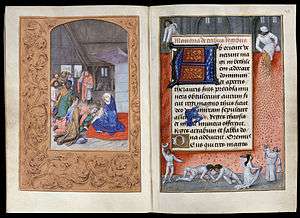Ghent-Bruges school

Alexander Bening, Adoration of the Magi, before 1483, British Library
The Ghent-Bruges School is a manner or movement of manuscript illumination from about 1475 to about 1550 that developed in southern Netherlands, now Belgium. The term was first used in 1891 by Joseph Destree, author of Recherches sur les elumineurs flamands and art historian Paul Durrieu.[1]
It replaced the "courtly style" of about 1440 to 1474 during the southern Netherlands reigns of Philip the Good and Charles the Bold. That mid-15th-century style consisted of works in primary colors of "wooden, clumsily painted stock figures".[1]
The Ghent-Bruges School style created illuminated manuscripts with realistic images of people, including half- and full-length portraits, colorful landscapes and the use of bright and pastel colors.[1]
Notable artists
See also
References
- 1 2 3 Jane Turner. The Grove Dictionary of Art: From renaissance to impressionism : styles and movements in western art 1400-1900. St. Martin's Press; 2000. ISBN 978-0-312-22975-7. p. 118.
This article is issued from Wikipedia - version of the 10/11/2016. The text is available under the Creative Commons Attribution/Share Alike but additional terms may apply for the media files.